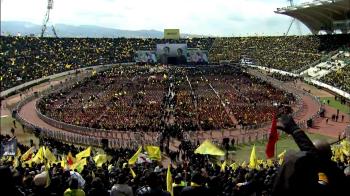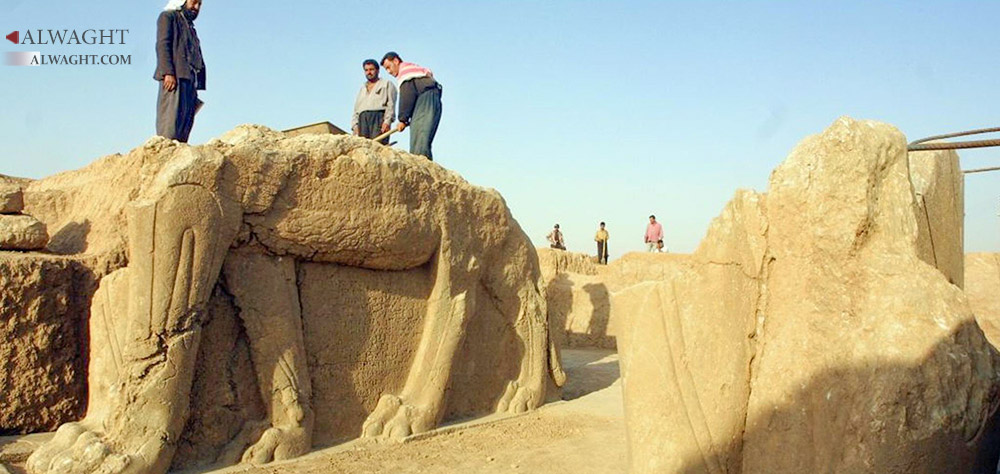Shocking destruction in the Syrian city of Palmyra is part of the militant group's ongoing campaign against archaeology.
Hatra
Built in the third century B.C., Hatra was the capital of an independent kingdom on the outskirts of the Roman Empire. Its combination of Greek- and Roman-influenced architecture and Eastern features testify to its prominence as a trading center on the Silk Road. Hatra was named a UNESCO World Heritage site in 1985.
In 2014, Hatra was taken over by ISIS and reportedly used as an ammo dump and training camp. A video released by ISIS in April 2015 showed fighters using sledgehammers and automatic weapons to destroy sculptures in several of the site’s largest buildings. "The destruction of Hatra marks a turning point in the appalling strategy of cultural cleansing underway in Iraq," UNESCO head Irina Bokova said at the time.
Nineveh
Ancient Assyria was one of the first true empires, expanding aggressively across the Middle East and controlling a vast stretch of the ancient world between 900 and 600 B.C. The Assyrian kings ruled their realm from a series of capitals in what is today northern Iraq. Nineveh was one of them, flourishing under the Assyrian emperor Sennacherib around 700 B.C. At one point, Nineveh was the largest city in the world.
Its location on the outskirts of Mosul—part of the modern city is built over Nineveh's ruins—put it in ISIS's crosshairs when the group took over the city in 2014. Many of the site's sculptures were housed in the Mosul Museum (see entry below), and some were damaged during the rampage through the museum documented on video. Men were also shown smashing half-human, half-animal guardian statues called lamassus on Nineveh's ancient Nirgal Gate. “I’m not sure there’s much left to destroy in Mosul,” says Columbia’s Jones.
Mosul Museum and Libraries
Reports of looting at Mosul's libraries and universities began to surface almost as soon as ISIS occupied the city last summer. Centuries-old manuscripts were stolen, and thousands of books disappeared into the shadowy international art market. Mosul University's library was burned in December. In late February, the ISIS campaign escalated: Mosul's central public library, a landmark built in 1921, was rigged with explosives and razed, together with thousands of manuscripts and instruments used by Arab scientists.
The book burning coincided with the release of the video showing ISIS fighters rampaging through the Mosul Museum, toppling statues and smashing others with hammers. The museum was Iraq's second largest, after the Iraq Museum in Baghdad. Statues included masterpieces from Hatra and Nineveh.
Margarete van Ess, head of the German Archaeological Institute's Iraq field office, says that a trained eye can tell that about half of the artifacts destroyed in the video are copies; many of the originals are in the Iraq Museum.
Nimrud
Nimrud was the first Assyrian capital, founded 3,200 years ago. Its rich decoration reflected the empire's power and wealth. The site was excavated beginning in the 1840s by British archaeologists, who sent dozens of its massive stone sculptures to museums around the world, including New York's Metropolitan Museum of Art and the British Museum in London. Many originals remained in Iraq.
The site itself is massive: An earthen wall surrounds 890 acres. The Iraqi Ministry of Tourism and Antiquities says ISIS bulldozed parts of the site, but the extent of the damage isn't yet clear. Some of the city was never uncovered and remains underground—protected, one hopes.
Khorsabad
Khorsabad is another ancient Assyrian capital, a few miles from Mosul. The palace there was built between 717 and 706 B.C. by Assyria's King Sargon II. Its reliefs and statues were remarkably well preserved, with traces of the original paint still decorating depictions of Assyrian victories and royal processions.
Most of the reliefs and many of the statues were removed during French excavations in the mid-1800s and by teams from Chicago's Oriental Institute in the 1920s and '30s, and are now in the Iraq Museum in Baghdad as well as in Chicago and the Louvre in Paris. It's not clear what part of the site ISIS targeted.
"We don't have photography showing how far the damage might go," van Ess says. "The only information right now is from local people and Iraqi antiquities ministry."
Mar Behnam Monastery
Established in the 4th century, the monastery was dedicated to an early Christian saint. The holy site, maintained since the late 1800s by Syriac Catholic monks, survived the Mongol hordes in the 1200s but fell to ISIS in March. The extremists used explosives to destroy the saint’s tomb and its elaborate carvings and decorations.
Mosque of the Prophet Yunus
Mosul's Mosque of the Prophet Yunus was dedicated to the biblical figure Jonah, considered a prophet by many Muslims. But ISIS adheres to an extreme interpretation of Islam that sees veneration of prophets like Jonah as forbidden. On July 24, ISIS fighters evacuated the mosque and demolished it with explosives.
Like many of Iraq's sites, the mosque was a layer cake of history, built on top of a Christian church that in turn had been built on one of the two mounds that made up the Assyrian city of Nineveh.
Imam Dur Mausoleum
The Imam Dur Mausoleum, not far from the city of Samarra, was a magnificent specimen of medieval Islamic architecture and decoration. It was blown up last October.
Source: nationalgeographic.com



























